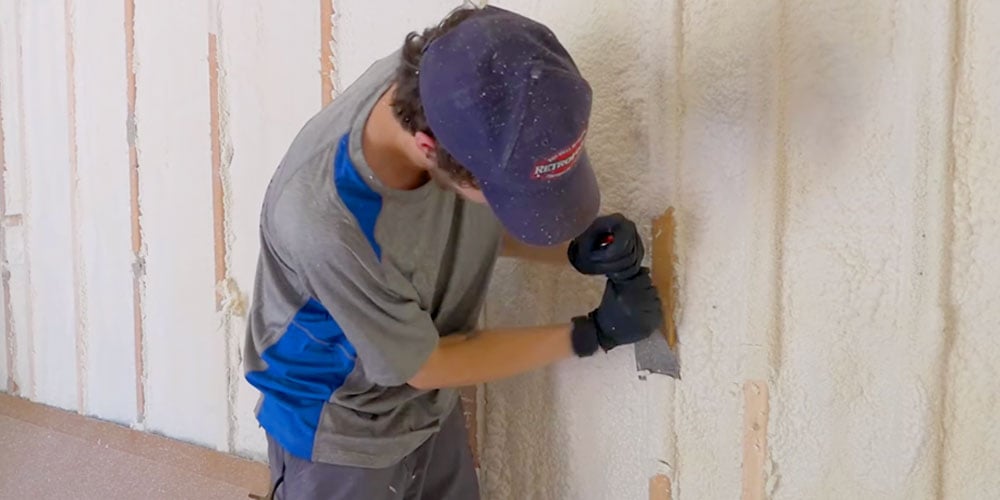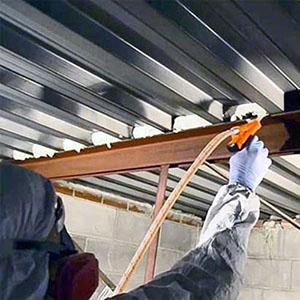Spray Foam: The Ultimate Service for Air Sealing and Insulation
Spray foam insulation has emerged as a leading solution for effective air securing and thermal insulation, supplying an unique mix of properties that set it apart from typical approaches. Recognizing the full scope of its benefits, installment procedures, and comparisons with other insulation kinds is vital for making notified decisions.
What Is Spray Foam?
Spray foam is a versatile insulation product that integrates the principles of air securing and thermal resistance to boost energy efficiency in structures. Made up mainly of polyurethane or other similar substances, spray foam is applied as a liquid that increases upon call with surface areas, producing a solid, continuous layer of insulation. This one-of-a-kind home enables it to fill spaces, cracks, and spaces that conventional insulation materials may overlook, giving a superior air seal.
There are two major sorts of spray foam: open-cell and closed-cell. Open-cell spray foam is lighter and extra versatile, supplying exceptional audio absorption and a lower R-value per inch - Spray Foam. On the other hand, closed-cell spray foam is denser, giving a higher R-value, moisture resistance, and included structural integrity to building parts
The application process generally involves customized devices, making sure a seamless application that adheres to numerous substratums, including metal, concrete, and timber. This versatility makes spray foam ideal for both new building and constructions and retrofitting existing structures. Its capability to produce an impermeable obstacle dramatically adds to lowering power intake and enhancing interior air high quality, consequently making it a preferred choice among home owners and builders alike.
Benefits of Spray Foam Insulation
One of the most considerable benefits of spray foam insulation is its remarkable capability to produce a continual air obstacle, which properly decreases power loss. Unlike traditional insulation materials, spray foam expands to fill fractures and spaces, making sure that air leak is substantially reduced. This particular not just boosts power performance yet additionally brings about decrease energy expenses in time.
Furthermore, spray foam insulation offers exceptional thermal resistance, adding to an extra steady indoor environment. Its high R-value per inch enables reliable insulation in constrained areas, making it optimal for attics, walls, and crawl rooms. The moisture-resistant residential or commercial properties of spray foam aid stop mold and mildew development, promoting much healthier living problems.
One more critical advantage of spray foam insulation is its sound-dampening high qualities (Spray Foam). It effectively lowers noise transmission in between spaces, creating a quieter and a lot more comfortable home setting. The toughness of spray foam also attracts attention, as it does not sag or settle gradually, maintaining its efficiency throughout its lifespan
Just How Spray Foam Works
Comprehending how spray foam insulation functions is important for valuing its effectiveness in air securing and thermal resistance. Spray foam insulation contains two key components: isocyanate and polyol material. When these components are blended, they undertake a chain reaction that creates the material to broaden rapidly, creating a thick foam that fills spaces, splits, and tooth cavities.
As the foam broadens, it complies with surfaces, forming an impermeable seal that significantly decreases air seepage. This particular makes spray foam insulation highly effective at stopping drafts and dampness infiltration, which can lead to energy loss and damage gradually. In addition, the closed-cell version of spray foam offers exceptional thermal resistance because of its stiff framework, properly decreasing heat transfer.
The unique residential properties of spray foam permit it to satisfy uneven surface areas, ensuring comprehensive coverage and a seamless barrier. Because of this, spray foam insulation not just boosts power performance yet additionally adds to enhanced interior air high quality by minimizing the build-up of pollutants and allergens. Inevitably, recognizing the technicians behind spray foam emphasizes its function as a remarkable option for insulation and air sealing in both residential and commercial applications.
Installment Process Overview

Before setup, the room should be appropriately cleaned up and prepped, making certain that surfaces are devoid of debris, dust, and dampness. This action is important due to the fact that impurities can compromise bond and general efficiency. Once the area is prepared, the application involves mixing both elements of the spray foam, which increases upon call and loads voids effectively.
Trained professionals ought to carry out the setup, using specific devices to make sure consistent insurance coverage and optimum thickness. Security safety measures, consisting of using protective gear and guaranteeing proper ventilation, are critical throughout this procedure. After application, the foam normally treatments swiftly, developing a solid barrier that boosts power performance.
Comparing Spray Foam to Conventional Insulation
When assessing insulation options, spray foam insulation stands out in contrast to typical products such as fiberglass and cellulose. One of the primary benefits of spray foam is its remarkable air sealing capabilities. Unlike fiberglass and cellulose, which can permit air seepage, spray foam broadens upon application, filling crevices and gaps to develop a closed seal. This results in boosted energy efficiency, as much less heated or cooled down air gets away the home, resulting in lower energy expenses.
Furthermore, spray foam gives a greater R-value per inch than traditional insulation kinds, providing even more effective thermal resistance in a thinner account. This characteristic is specifically advantageous in rooms with restricted dental caries depth. Spray foam is resistant to dampness and mold growth, which can be a substantial issue with cellulose and fiberglass, especially in moist atmospheres.
Nonetheless, spray foam insulation typically lugs a higher upfront price than its typical counterparts. House owners have to consider this first financial investment versus long-term energy cost savings and efficiency advantages. Ultimately, while navigate here both insulation types serve their function, spray foam becomes an advanced service for contemporary insulation requirements, specifically in regards to air securing and thermal efficiency.

Verdict
In recap, spray foam insulation stands for a very reliable remedy for attaining optimum air securing and thermal resistance. Its special residential see this properties, consisting of wetness resistance and noise dampening, make it appropriate for various applications in both new constructions and retrofitting tasks (Spray Foam). Although the first prices might be higher compared to traditional insulation products, the long-lasting benefits, such as significant power financial savings and enhanced indoor air quality, warrant the financial investment and highlight its value in modern structure methods.
Spray foam insulation has actually emerged as a leading remedy for efficient air sealing and thermal insulation, using a distinct mix of residential properties that set it apart from typical techniques.Spray foam is a functional insulation material that incorporates the principles of air securing and thermal resistance to enhance power effectiveness in structures.When examining insulation options, spray foam insulation stands out in comparison to typical materials such as fiberglass and cellulose. Inevitably, while both insulation types offer their purpose, spray foam emerges as an extra advanced option for modern insulation requirements, specifically next in terms of air sealing and thermal effectiveness.
In recap, spray foam insulation represents an extremely reliable service for attaining optimal air sealing and thermal resistance.
Comments on “Leading Applications of Spray Foam for Residential and Commercial Properties”